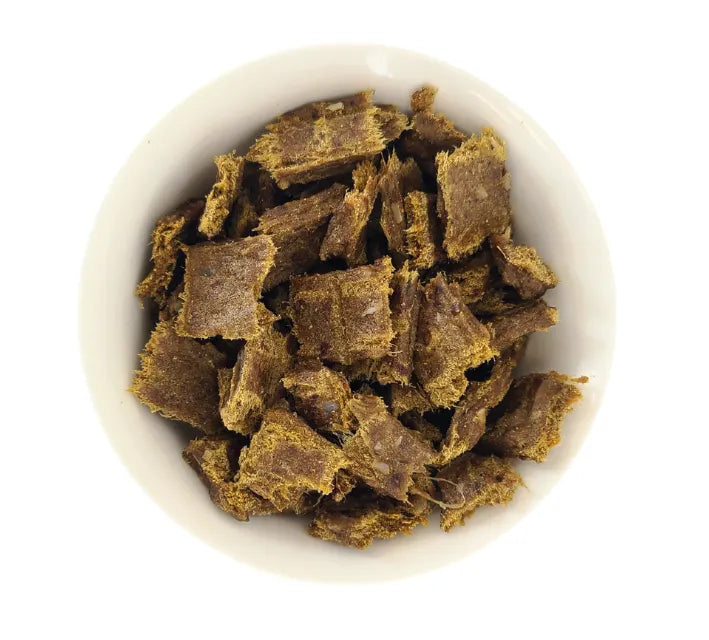
The nutrition of raw pet food... with the convenience of kibble
Ever wondered how our raw, dehydrated food really compares to dry kibble? Our recipes are handcrafted with fresh whole meats and organic, high-quality produce, creating out of-the-bag convenience with the concentrated natural nutrition of raw food. We offer the perfect combination of raw, fresh food in an easy-to-serve format - no fridge or freezer required!
Read on for more about how our raw, dehydrated food measures up to kibble:
1. We gently dehydrate our food
Unlike kibble, which is cooked to extreme temperatures several times (reducing the quality of the food), we use a gentle dehydration process which keeps the natural, beneficial enzymes needed for good gut health.
2. We do not use fillers
While traditional kibble recipes often contain up to 60% carbohydrates (which dogs and cats have no biological requirement for), our recipes have only 3-10% - no rice, oats, grains, potatoes or fillers.
3. Our food is shelf-stable
Whereas traditional kibble formulas can oxidize and become stale in as little as two weeks, our food is shelf-stable.
4. We do not add artificial vitamins or synthetics
Our recipes are made with human-grade, non-medicated meats (no added hormones), along with non-gmo, organic fruit and vegetables. We add no artificial vitamins or synthetics - all the nutrition comes from the food itself!
5. We have never had a recall
Period.
FAQs
Why is organic non GMO produce important?
Organic foods often have more beneficial nutrients, such as antioxidants, than their conventionally-grown counterparts and people with allergies to foods, chemicals, or preservatives may find their symptoms lessen or go away when they eat only organic foods. In essence, organic produce contains fewer pesticides.
What is ethoxyquin? And why should I care about synthetic vitamins and minerals?
Ethoxyquin (E324) is a synthetic antioxidant that is used primarily in animal feed. Globally, ethoxyquin is not approved for use as a direct food additive in foods for human consumption. Specific to the omega-3 industry, some krill meals and crude fish and fish oils for animal feed are preserved using ethoxyquin.
Naturally occurring vitamins and synthetic vitamins are different … really different.They’re not in the same chemical form … so your dog’s body will have trouble recognizing and using the fake, synthetic vitamins. These synthetic vitamins and minerals, even at the best quality, regularly have partially hydrolyzed protein carriers of unknown sources and are almost exclusively available from overseas sources. This means they can be contaminated with toxins, or at the very least, be a source of allergens to some pets.
Why is carbohydrate content and source important?
Dogs and cats have no biological requirement for simple carbohydrates. Some of these also contain a good portion of the food's protein levels, which are simply not easy to digest or particularly bioavailable. Basically a lot comes out the back end…in the form of excrement. So it may look like a high protein food, but much of it comes from peas or potatoes, not appropriate sources for dogs and cats. Some are more concerning than others, like peas, lentils and those in the legume family. They contain lectins (plant proteins) and phytoestrogens.They can damage your dogs gut, leading to leaky gut symptoms and they provide a continuous source of plant based estrogens which interfere with a normal endocrine system.
Why should I care if there is gluten in the food?
Dogs are usually sensitive to gluten, not grains themselves. Not only is it one of the top 5 allergens for pets, but it’s also inflammatory and can affect a dog's healthy gut biome.
Why is the amount fed important?
Calorie density is important. It’s very hard for your pet to digest and work on massive amounts of food consumed in any given meal. As illustrated above, when we’re feeding 3+ cups of food (vs ¾ cup) this indicates a large portion of low calorie fillers, which will be partially fermented in the gut and come out the other end. Simply put, excessive food tends to equal excessive excrement. It also indicates that a lot of the food’s ingredients are those hard-to-digest carbohydrates.
Why is Smack more expensive than kibble?
Although everyone has a different budget when it comes to pet food, if you factor in the importance of quality food as a form of preventative medicine, Smack is an affordable way to feed your dogs and cats. After all, when you feed your pet a raw dehydrated diet such as Smack, you’re not just feeding them; you’re giving them improved nutrition and positively impacting their overall health and well-being.
To help illustrate - we put 20 lbs of whole raw foods into every 5.5 lbs bag of Very Berry Chicken, which retails for $109.99 and contains 25 cups. Recommended feeding for an average 50 lbs dog is 1.25 cup, which works out to just $5.50/day! You will always be able to find foods which are which are both more and less expensive than Smack, but you won't find one that will match Smack’s quality, value, palatability, and positive impact on your dog's well-being! Better food = a healthier pet and less money down the road as your pet ages.
Why don't you offer a larger bag size?
Dry food oils and nutrients start to oxidize within 3 weeks. Smaller bags equal fresher, safer, more nutritious foods.
